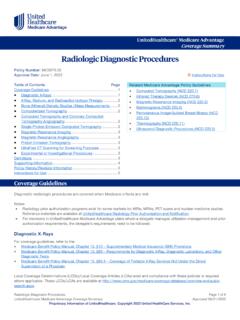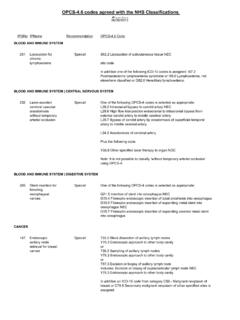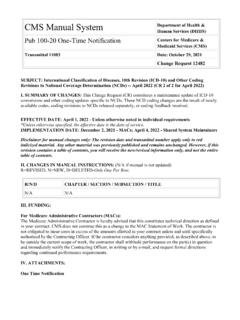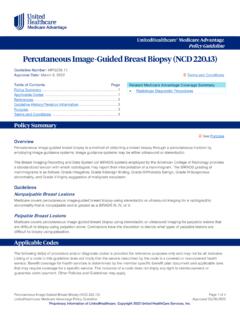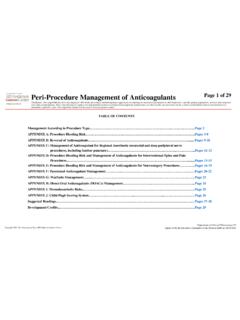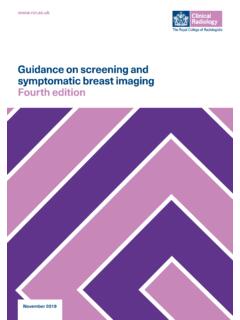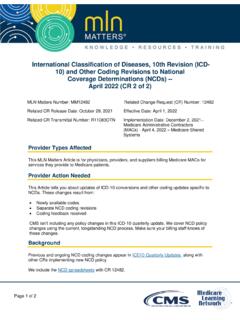Transcription of Consensus Guideline on Concordance Assessment of …
1 - Official Statement - Consensus Guideline on Concordance Assessment of image - guided breast Biopsies and Management of Borderline or High-Risk Lesions Purpose To outline the management approach for borderline and high risk lesions identified on image - guided breast biopsy . Associated ASBrS guidelines or Quality Measures 1. image - guided percutaneous biopsy of Palpable and Nonpalpable breast Lesions 2. Performance and Practice guidelines for Stereotactic breast Procedures 3. Concordance Assessment Following image - guided breast biopsy Methods Literature review inclusive of recent randomized controlled trials evaluating the management of various borderline and high-risk lesions (including atypical hyperplasia, lobular neoplasia, papillary lesions, radial scars and complex sclerosing lesions, fibroepithelial lesions, mucocele-like lesions, spindle cell lesions, and pseudoangiomatous stromal hyperplasia [PASH]) identified on image - guided breast biopsies.
2 This is not a complete systematic review but a comprehensive review of the modern literature on this subject. The ASBS Research Committee developed a Consensus document which the ASBS. Board of Directors reviewed and approved. Summary of Data Reviewed percutaneous core needle biopsy (CNB) is the preferred, initial, minimally invasive diagnostic procedure for nonpalpable breast lesions or palpable breast Concordance Assessment of the histologic, imaging, and clinical findings determines further management. Discordance refers to the situation in which a breast CNB demonstrates benign histology, while the clinical or imaging findings are suspicious for malignancy. If there is discordance between imaging and pathology, histological evaluation is still needed. This can be accomplished either by repeat CNB, perhaps with consideration of larger gauge or vacuum- assisted device, or surgical Some nonmalignant CNB findings are considered borderline because of their potential association with malignancy.
3 Such borderline lesions include atypical ductal hyperplasia 2. (ADH), lobular neoplasia (atypical lobular hyperplasia or lobular carcinoma in situ), papillary lesions, radial scars (complex sclerosing lesions), fibroepithelial lesions, columnar cell lesions (hyperplasia or flat epithelial atypia), spindle cell lesions, mucocele-like lesions, and pseudoangiomatous stromal hyperplasia (PASH). These lesions potentially can be upgraded to malignancy at surgical biopsy secondary to sampling volume limitations of CNB or inaccurate ,6-7 For this reason, a CNB result with one of these histologic findings requires correlation with imaging and clinical findings to determine Concordance , and to either exclude the diagnosis of a malignancy by further histological evaluation or to establish a formal plan of follow-up through risk-based, shared decision-making with the ,5-8.
4 If CNB was performed for mammographic calcifications, then radiographic and microscopic confirmation of calcifications in the specimen should be documented; otherwise, further efforts to identify and excise them are indicated. If imaging reveals features suspicious for malignancy, such as a spiculated or irregular mass or architectural distortion, and histology reveals a nonmalignant diagnosis, then further clinical-radiologic-pathologic correlation is needed to estimate the chance of upgrading the diagnosis to malignancy with surgical , 5-7. Management of nonmalignant lesions found on CNB should be determined on a case-by-case basis because there is variability in the imaging and pathology features for all the benign and borderline lesions discussed below and because there is a wide range of reported upgrade rates from benign to malignant disease at the time of surgical excision for these , 6-7.
5 Most of the available literature regarding upgrading rates for these lesions is retrospective. A variety of factors are reported to influence the likelihood of pathology upgrading, including year of study publication, institution, specialist pathology interpretation, persistence of the target lesion on imaging, palpability of the lesion, size and type of needle used for sampling, size of the lesion, preprocedure BI-RADS score, presence of a mass or calcifications, and patient baseline breast cancer risk. The literature is variable and there is lack of uniformity of opinion regarding the necessity of surgical excision for many of these lesions. While surgical excision is the most definitive approach, given the lack of data to guide management, close observation and careful follow-up is an acceptable option for selected patients and for lesions with a lower chance of upgrade; however, the patient should play an active role in such decisions.
6 When opting for surveillance instead of surgical excision, patient compliance with follow-up needs to be considered. The following sections provide a brief overview of the literature currently available regarding upgrade to malignancy and indications for surgical excision for the most common borderline lesions. Indications for surgical excision for atypical ductal hyperplasia (ADH): ADH is associated with an increased risk of future breast cancer and, when identified on CNB, may be associated with malignancy. For this latter reason, ADH identified on CNB is often surgically excised; rates of upgrade to ductal carcinoma in situ (DCIS) or invasive carcinoma are variable in the literature but are often >20%,9-13 and on CNB it may be difficult to differentiate ADH from low- volume DCIS. Multiple factors have been associated with 3. upgrade in the literature, as discussed above.
7 Khoury et al created a nomogram using several such factors, designed to predict the likelihood of upgrade at surgical excision, with an area under the curve of Other authors have also suggested treatment algorithms for managing patients with atypia diagnosed on CNB. Caplain et al. reported institutional guidelines that ADH does not need to be excised if it is (a) < 6 mm in size and completely removed or (b) <6 mm in size and incompletely removed but <2 foci. Of 41 cases excised contrary to the guidelines , only one was upgraded at surgery, for an upgrade rate of 2%. ADH. excised as prescribed by institution guidelines , by comparison, had an upgrade rate of 37%.15. These data suggest that there may be a subset of ADH that can safely be observed. However, given the variability in the available literature, most cases of ADH should be excised. Indications for surgical excision of lobular neoplasia (lobular carcinoma in situ [LCIS] and atypical lobular hyperplasia [ALH]): Similar to ADH, lobular neoplasias are associated with an increased risk of future breast cancer and, when surgically excised, may be associated with in situ or invasive malignancy.
8 As with ADH, the risk of upgrade in the literature is variable16-19 and therefore these lesions are often excised. However, there is a growing body of literature suggesting that the likelihood of upgrade is low (<5%) with small volume lobular neoplasia and in the setting of imaging-pathologic In a recent report by MD Anderson, surgical excision is recommended in cases of discordance, and is more likely to be recommended for LCIS (versus ALH), for targeted versus incidental lesions, in cases with fewer cores taken, and for mass lesions. These same factors were associated with a risk of upgrading with surgical Whether or not patients with ALH and LCIS on core biopsy specimens require surgical excision is a matter of controversy. Several recent studies suggest that when a core- biopsy - based diagnosis of lobular neoplasia is made, and no other lesions requiring excision (ADH, papilloma, radial scar) are present, and radiological pathological Concordance is present, upgrade rates are less than 5%.
9 23-27 As a result, we no longer advocate routine excision of ALH or LCIS when the radiological and pathological diagnoses are concordant, and no other lesions requiring excision are A number of non-classical LCIS variants, including pleomorphic, with necrosis, signet ring, or apocrine, exist. These lesions tend to have high-grade cytology and an unfavorable biomarker Current evidence suggests these lesions, and pleomorphic LCIS, in particular, should be treated with complete surgical excision, similar to Indications for surgical excision for columnar cell lesions (CCL), CCL with atypia, flat epithelial atypia (FEA): CCLs are often identified with mammographic calcifications and are characterized by enlarged terminal ductal lobular units lined by columnar epithelial cells with apical snouts. Atypia may be identified with this epithelium. 25 If so, this has been termed a CCL-A or Based on a systematic review of 24 studies reporting on patients with CCLs identified at needle biopsy , the upgrade rate to DCIS on excision was , 9%, and 20% in patients with pure CCLs, CCL-A (FEA), and CCLs with Some authors recommend that CCLs with atypia (FEA) undergo or be offered Morrow et al.
10 And other authors suggest that observation of FEA without associated ADH is a reasonable strategy, if there are no other indications for , 35-38. 4. Indications for surgical excision of papillary lesions: Papillary lesions, as a term, encompass a range of pathologies including intraductal papillomas, and these lesions may be associated with atypia. Papillary lesions with atypia are pathologically upgraded at the time of surgical excision up to 67% of the time, and surgical excision for these lesions is widely However, literature focusing on papillary lesions without atypia is mixed, and there is yet little Consensus . Reported rates of upgrade of pure papillary lesions to atypia or malignancy are highly variable, historically ranging from 5% - 20%, but trending to less than 10% in the last Most available data are retrospective, and there is little agreement between studies regarding the clinical and imaging findings predictive of upgrading at the time of surgery, making it difficult to know who is likely to benefit from surgical excision.


